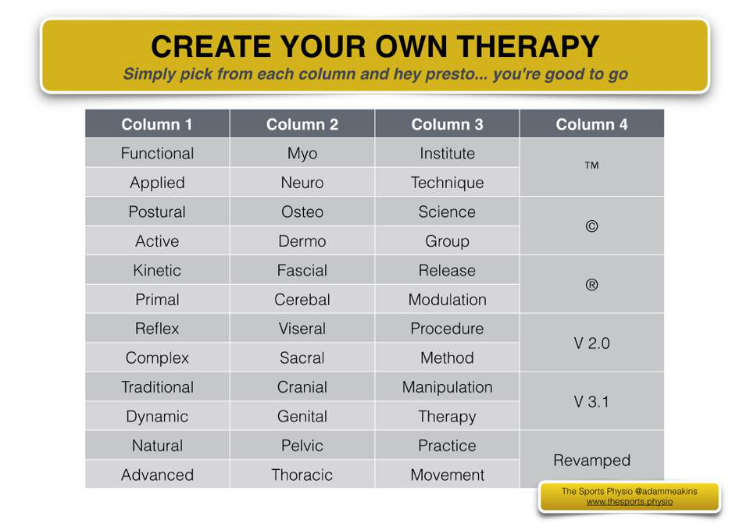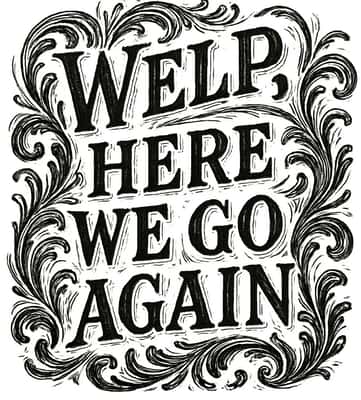Modality Empires
The trouble with the toxic tradition of ego-driven, trademarked treatment methods in physiotherapy, massage therapy, chiropractic
“Modality empire” is my own term1 for a proprietary method of treatment — a sub-discipline — championed and promoted by a single entrepreneur who is likely to suffer from a serious case of healer syndrome. They dominate the manual therapies.2 Most are based on pseudoscience, and and many are arguably fraudulent, for both professionals and patients.
It’s important to know this if you have a chronic pain problem, because so many of the therapies that will be offered to you are the dubious, profit-corrupted products of modality empires. You should actually be suspicious of fancy-sounding technique certifications, like “Level IV Fascia Reintegration Specialist.”
It’s also important for professionals to understand the menace of modality empires! Continuing education should mainly be about actual education — acquiring knowledge! And the emphasis should be on “how to think, not just what to think” (Jason Erickson, HealthArtes.com). It should not be about purchasing the right to say that you use a trademarked technique — especially one that is almost certainly nonsense.
While there are many taxonomies of alternative medicines, one thing almost all alternative therapies have in common is they are originally the de novo “discovery” of one lone individual.
Dr. Mark Crislip, “The Marshall Protocol” on Science-Based Medicine
Big promises and hard selling
Most modality empires make big promises of healing powers and high success rates, and usually make their money by selling workshops, books, and very expensive therapy provided by the founders and their early proteges. Even if the brand isn’t strong enough to command high fees, they are inevitable if the business succeeds. Professionals are usually sold on the opportunity to purchase credibility in the form of increasing “levels” of certification, but the quality of these certifications is completely unregulated, and it’s debatable how much demand there really is for such dubious “credentials.”
Modality empires are the apotheosis of the principle that the most marketable ideas dominate treatment and therapy for pain.3 They usually revolve around an overly simplistic notion of how the body works and how it might be fixed. In particular, modality empires tend to be based on “structuralism,” which is the emotionally compelling idea that our problems are caused by being “crooked” in some way, and that all our problems will be solved when we are “straightened” by therapy. Unfortunately, there is a great deal of evidence that this view of chronic pain is not fruitful.4 Some classic examples of modality empires include:
- Ida Rolf’s ROLFING®
- John Upledger’s craniosacral therapy
- David Graston’s Graston Technique® (although he no longer owns the brand)
And here are a couple good modern examples, brands that have been “hot” in the last decade or so. Again, not necessarily saying these are bad, just very clearly branded:
- Sue Hitzmann’s MELT Method®, which has aggressively made a brand from hype about the alleged clinical relevance of fascia.
- Lee Burton’s Functional Movement Screen (an interesting example in many ways).
There are many more, and some certainly are bad. (There are examples that I am unwilling to mention by name because they are infamous for legal bullying of their critics.)
A lack of originality is another major characteristic. There isn’t much in the world of manual therapy that’s new under the sun, and many modalities are really just minor variations on generic old therapeutic concepts that no one should be trying to put a new name on. Some modality empires are particularly unoriginal in my opinion, blatantly re-packaging old ideas for a new generation of workshop consumers, like Paul St. John’s take on trigger point therapy (St. John Neuromuscular Therapy™). And to the extent that they are original, they almost always rely on untested treatment ideas based solely on the experiences and pet theories of the founder, and probably wouldn’t stand up to science-fair level critical analysis.

A handy chart from snarky physiotherapist blogger Adam Meakins: “Business a bit slow? Want to stand out from the competition? Looking for that marketing edge? Here’s the answer! Develop your own therapy … ”
Ahead of the science
A lasting guru culture exists in physical therapy, promulgating an ugly self righteousness: “follow me first and then maybe the science.”
Dr. David Butler, “What is the difference between cancer & whiplash?”
When you’re selling a method, you want customers to believe it’s ahead of the science — that it will be validated by science someday. Anyone is entitled to make this bet, but for everyone who actually turns out to be an ahead-of-her-time genius, there are a thousand, or ten thousand, who were just kidding themselves.
Almost all theories turn out to be wrong. Scientists know this. Understanding how things really work is really hard.
Modality emperors usually want to seem science-y, but when challenged they quickly turn on science: “Science doesn’t know everything.” No, it doesn’t. But what a terrible, shallow attitude!5

You can’t patent “nice”
Compassionate contact will always be by far the most important part of massage, no matter what alleged technical innovations anyone tries to sell.
Modality empires are businesses
A modality empire is as much a business model as a method of helping people, and perhaps much more. There is a great deal of overlap between modality empires and quackery. Please note that “overlap” is not a blanket condemnation: I am not saying that everything about modality empires is wrong, or that every modality empire is equally bad. Many modality emperors are also genuinely formidable innovators and experts, and much of value can be found in their methods and teachings.
However, as the old joke about lawyers goes, “Only 90% of them are making the rest look bad.”
History has shown us time and again that what drives the popularity of a modality empire is not how well it works, but simply how well it is promoted. Once in a while, a well-promoted modality empire hits the big time and become full-fledged profession. Chiropractic is the most obvious example: it began as the modality empire of master marketer DD Palmer, and then his son BJ, and they spent decades pushing it to the status of a regulated profession. The Palmers were certainly entrepreneurial geniuses, but they also promoted many ideas that have long since been abandoned as useless … even by some chiropractors.6
“Success rates” are meaningless
Advertising a high "success rate" is a classic modality empire marketing ploy. Most people know better than to believe a highly inflated number, but we need to be skeptical even of more modest claims, like, “I find about 70% of people get better with this approach.”
That is not something individual clinicians can actually know. Clinical outcomes are subject to a dazzling number of confounding factors — so many that estimates are basically meaningless. Most importantly, clinicians have a badly skewed sample: patients tell them about perceived successes much more than failures. See Overestimating “success rates” (for dry needling).
Claiming a high success rate always strongly implies that the idea of the modality is sound. However, even an actually high success rate doesn’t actually constitute validation of method. Again, the confounding factors: there are many ways that people can actually get better that have nothing to do with the alleged “active ingredient” in the therapy.
A very modern example: Cognitive Functional Therapy training now for sale
Cognitive Functional Therapy (CFT) is a fascinating and nuanced example of a brand new modern modality empire. It’s interesting because it repudiates all the structuralist ideas that most modality empires were founded on, making it a “lesser of evils”! The problem is that it still isn't actually evidence-based … and, perhaps, is just as pseudoscientific in a new and different way.
And yet CFT training is now for sale, as cynically feared by some, and eagerly anticipated by others. A timeline …
May 2023 — The RESTORE trial of CFT for low back pain is published, and it sure looks good, a seemingly strong scientific vote of confidence for “an individualized approach that targets unhelpful pain-related cognitions, emotions, and behaviours that contribute to pain and disability.” For a while, I want to believe!
December 2023 — I write an extensive critique, reporting on RESTORE’s significant flaws and the concerns of many experts and professionals. One of the biggest? That the trial would be exploited to commercialize and promote CFT training and certification, with all the usual corrupting effects of revenue and reputation.
May 2025 — The “Cognitive Functional Therapy tiered training program” launches. It took two years, but the boost from the putatively positive results of RESTORE have now officially been “monetized," albeit quite softly at this time (it’s inexpensive). And it looks like the kind of thing that many of us cynically predicted.

What’s the big deal? What could possibly go wrong? Being idealistically affordable is nice, but “profit” is not the only concern: any revenue, reputation, and intellectual investments are also strong corrupting forces. Training potently legitimizes ideas and methods that, in this case, have not only not been proven clinically effective, but have arguably been proven to be not very effective.
The branding and standardization of therapy methods is nearly impossible to do without “selling out” in one sense or another, thanks both to perverse incentives and overwhelming social pressures in the wrong directions. Most professionals and patients easily succumb to the allure of a methods endorsed by experts, and the assumption that “there must be something to it”… and are largely oblivious to how precarious that is. Even the best seem doomed to morph into dumbed-down dogma, and to produce at least one or two generations of therapists still clinging to it long after science has pointed out that their emperor has no clothes — thanks to their investment in imitating the emperor’s wardrobe.
A method of therapy can truly be a good idea, founded by people who are smart and wise … and still become a simplistic parody of itself when it becomes any kind of business. That’s the danger. Even if CFT is actually great. Which is far from guaranteed. And so there is a serious risk that CFT — non-profit or not — will now become just another “modality empire,” prioritizing its revenue, reputation, and continuing existence over good clinical science.
That is what could possibly go wrong.
Why aren’t customers cynical about modality empires? A double standard
What puzzles me most about the promotion of modality empires is how effective they are at fooling people who are cynical about other kinds of businesses — both professionals and patients. Modality empires actually attract customers who hate The Man, corporate greed, and especially Big Pharma. Yet these “sensitive” consumers turn off their cynicism and give a free pass to most modality empires, even though they are — by definition — corrupted by ego (at least) and by massive profits in some cases. Why the double standard?
It’s just marketing 101. Modality empires are able to successfully cast themselves in the role of the underdog just by emphasizing how they are an alternative to everything the customer is cynical about — the target market is super cynical about “mainstream medicine,” and so it’s very easy for a modality empire to make itself look appealing by taking shots at mainstream medicine.
Also, the marketing of most modality empires is usually finely honed by market forces. That is, they primarily exist to give people the health care they want, and not the health care that works — two surprisingly different things, and history is packed with hair-raising examples.7 It really is the industry of emotionally appealing treatment ideas. The successful ones are successful precisely because they have found the right psychological buttons to push. Basically all modality empires are sold on the strength of an emotionally appealing idea or theme.
For instance, many of them are based on the idea of “alignment” — that if you are straighter, you will be healthier. As mentioned above, this “structural” view of pain is simplistic and generally false. The classic specific example is chiropractic, which, despite all of its pretensions, would never be able to survive as a profession without the simple, emotionally appealing idea that spinal alignment is vital to your general health. Clearly that is false, or every person with scoliosis or a simple spondylolisthesis (a scary-looking but generally asymptomatic condition) would be riddled with disease.8
Manual therapy needs to get beyond being “manual”
“Manual therapy” refers mainly to massage, spinal manipulation, and acupuncture for common musculoskeletal problems and injuries, services that are mostly provided by physical therapists, massage therapists, and chiropractors. It is a pseudoscientific dumpster fire, and what little good research exists shows little benefit.9 Modality empires have thrived on the on the idea of “magic” hands. They are all about “fixing flesh.”
Here’s an oblique indictment of the modality empires: in 2017, the journal Manual Therapy changed its name to Musculoskeletal Science & Practice. Their under-stated explanation:
The new title will better reflect current practice, education and research in the field of musculoskeletal physiotherapy worldwide and ensure that the journal continues to be a leading publication in the field
In other words, “manual therapy” is too narrow, too much about fixing people with techniques and magic hands, and neglects other perspectives and approaches. The change signals a general retreat from the belief that flesh and structure need to be changed … or even can be. It’s the writing on the wall that says that manual therapy needs to get beyond being “manual.”
The sketchiest methods will always be promoted the most aggressively.
The Salamander’s Law of Bad Therapy
What are the alternatives? Academic continuing education
The alternative is continuing education that is actually educational, focused on increasing general academic knowledge rather than skills, techniques, and methods. Learn from good teachers, writers, and subject matter dorks (also known as “experts”), rather than “gurus” and “masters” and course publishers that are too much about a “brand.” Some folks who are setting good examples:
- The Massage Therapist Development Centre, which offers good articles as well as courses like “Clinical Applications Of Pain Science: Manual Therapy, Exercise And Rehabilitation Principles For RMTs.” See also Eric Purves Professional Education (Eric is also involved in The MTDC).
- Greg Lehman does intimidatingly smart work, and teaches a pitch perfect course called “Reconciling Biomechanics With Pain Science” — which I think is exactly what the field most needs (and you can see why I think so in this article). He’s also particularly prolific and informative on Twitter.)
- Neuroscientific painmodulation is two days of pure education about pain and rehabilitation science, with a strong research focus, taught by physiotherapist and writer Lars Avemarie, well-known for his relentless science advocacy and debunking of nonsense. Of all the options here, this is the closest to being a seminar version of PainScience.com itself… and Lars might even have a bigger bibliography.
- Walt Fritz was once deeply involved in one of the most notorious guru-centric modality empires (John Barnes’ Myofascial Release Approach®), and chose to leave it behind to create something better. Cool! And cool for a long time now.
- Diane “Dermoneuromodulation” Jacobs. Diane’s thing can seem like just another modality to the uninitiated, but she’s dedicated to academic excellence rather than dogmatic methodology. She is a true expert.
- Laura Allen has been teaching and writing about massage therapy for as long as anyone I know of, and with a steadily increasing passion for science over the years. She earned a spot on this list the day she published Excuse Me, Exactly How Does That Work?
- The San Diego Pain Summit, an annual conference about the science of pain — where all the cool educators go to learn from each other. (I wouldn’t be surprised if literally everyone on this list has been. I haven’t myself, but that’s only because I’m a weird recluse with health issues that make travel hellish for me.)
- Adam Meakins, the sweary physio, does a terrific shoulder course: “The Shoulder: Complex doesn’t have to be complicated.”
PainScience.com is too small a shop to maintain an active, comprehensive directory of good providers of continuing education, especially as their numbers increase. But please let me know if you think I’ve neglected a particularly excellent example.
The price of honesty and humility
Many ethical healthcare pros refuse to jump on any the modality bandwagons. They cautiously, compassionately dare to educate patients that pain is too complex for any one treatment to be highly effective. In doing so, they routinely face disbelief, disapproval … even contempt. One massage therapist told me that her humility is not always well received:
“Some definitely think I just must not be good enough at my job.”
Awful! 😞
She can thank modality empires for that tragic attitude. They have been gushing too-good-to-be-true promises for decades. The crank, quacks, and snake oil salesmen pushing their branded methods have constantly and aggressively inflated consumer expectations, effectively training most of the people of Earth to believe that there must be easy answers to these hard problems. Even the cynics who assume that most of it is bullshit still think you just have to be savvy enough to buy the right therapy/gadget/supplement.
Be more cynical! And — please — appreciate and reward humility in healthcare when you see it. There are legitimate, effective treatments in pain medicine… but not many, and they tend to be either modest or specialized or both. See What Works for Chronic Pain?
Did you find this article useful? Interesting? Maybe notice how there’s not much content like this on the Internet? That’s because it’s crazy hard to make it pay. Please support (very) independent science journalism with a donation. See the donation page for more information & options.
About Paul Ingraham

I am a science writer in Vancouver, Canada. I was a Registered Massage Therapist for a decade and the assistant editor of ScienceBasedMedicine.org for several years. I’ve had many injuries as a runner and ultimate player, and I’ve been a chronic pain patient myself since 2015. Full bio. See you on Facebook or Twitter., or subscribe:
What’s new in this article?
Seven updates have been logged for this article since publication (2009). All PainScience.com updates are logged to show a long term commitment to quality, accuracy, and currency. more
When’s the last time you read a blog post and found a list of many changes made to that page since publication? Like good footnotes, this sets PainScience.com apart from other health websites and blogs. Although footnotes are more useful, the update logs are important. They are “fine print,” but more meaningful than most of the comments that most Internet pages waste pixels on.
I log any change to articles that might be of interest to a keen reader. Complete update logging of all noteworthy improvements to all articles started in 2016. Prior to that, I only logged major updates for the most popular and controversial articles.
See the What’s New? page for updates to all recent site updates.
Jun 26, 2025 — New section: “A very modern example: Cognitive Functional Therapy training now for sale.”
2022 — New section: “The price of honesty and humility.”
2021 — New section: “What are the alternatives? Academic continuing education.”
2018 — New section: “‘Success rates’ are meaningless.”
2017 — Added an excellent expert quote.
2016 — New section: “Manual therapy needs to get beyond being ‘manual’.”
2016 — Minor but fun: added Adam Meakin’s very amusing and apt random modality name generator.
2009–2016 — Many unlogged updates.
2009 — Publication.
Notes
- Charmingly, I have now seen it used “in the wild” a few times. It’s catching on!
- The “manual” therapists are the healthcare professionals who try to help people with their hands or tools: massage therapists, chiropractors, physical therapists, and osteopaths. They are all based on the premise that pain and injury are largely a function of anatomical and kinesiological abnormalities and stresses (“Your Back Is Not Out of Alignment”), and that these issues can be "fixed." The major manual therapy methods are massage therapy, joint manipulation, acupuncture, fascial therapy, trigger point therapy and dry needling. For an overview of all manual therapies, see Manual Therapy: What is it, and does it work? The science of hands-on treatments like massage and spinal manipulation to “fix” tissue.
- It’s just impossible to overstate how much marketing, hype, and clickbait have defined pain and injury treatment. This has been happening since the patent medicine era, more and worse with every decade. No bad idea ever dies — not if you can still sell it! The grift goes on and on. For a more detailed rant on this theme, see You’ve only heard of marketable pain treatments.
- Ingraham. Your Back Is Not Out of Alignment: Debunking the obsession with alignment, posture, and other biomechanical bogeymen as major causes of pain. PainScience.com. 21878 words.
- “Science doesn’t know everything” is a classic, common non-sequitur from people defending quackery. It’s true but obvious, and irrelevant to their point … which is that their kooky treatment beliefs are so exotic that they are immune to investigation and criticism, beyond the reach of science. Nope! Not even close! It’s like declaring a leaky old canoe to be seaworthy because we don’t yet know everything about the ocean depths.
- ScienceBasedMedicine.org [Internet]. Hall H. The End of Chiropractic; 2009 Dec 11 [cited 13 Nov 28]. PainSci Bibliography 55780 ❐
A well-written analysis of the significance of an important paper written by three chiropractors and a PhD (Mirtz et al.) about the scientific bankruptcy of subluxation theory.
- The colorful history of medicine and quackery is overflowing with people who “swore by” treatments that were bizarre and perilous. Even the worst had fans. People believe what they want to believe. For more information, see Popular but Weird & Dangerous Cures: The most dangerous, strange, and yet popular snake oils and “treatments” in history (and why anecdotes and testimonials cannot be trusted).
- Ingraham. Organ Health Does Not Depend on Spinal Nerves! One of the key selling points for chiropractic care is the anatomically impossible premise that your spinal nerve roots are important to your general health. PainScience.com. 4736 words.
- Ingraham. Manual Therapy: What is it, and does it work? The science of hands-on treatments like massage and spinal manipulation to “fix” tissue. PainScience.com. 3371 words.
